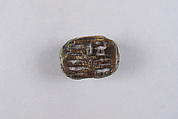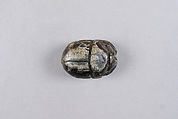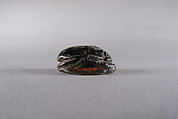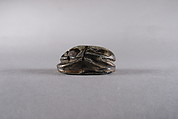Scarab of Kushite Ruler Senkamanisken
Late Period
The base of this scarab bears an inscription forming the name of a Kushite ruler. The duck and sun disk in the upper right corner leave no doubt about the royal status of the inscribed name, since the form the royal title Son of Re. The other hieroglyphs form the name Senkamanisken, the name of a Kushite king who ruled around 643-623 B.C. at Napata. This was the capital of Kush, the Nubian kingdom located south of Egypt. Senkamanisken is a contemporary of the Egyptian pharaoh Psamtik I of Dynasty 26 (ca. 664-610 B.C.).
A century earlier, around the mid-8th century B.C., the kings of Kush had conquered Egypt and ruled it for approximatively one century as Egypt’s Dynasty 25 (ca. 733-664 B.C.). Even though the Kushite kings no longer ruled Egypt in Senkamanisken’s time, he still adopted the title ‘son of Re,’ an Egyptian royal title, to emphasize his kingly status.
Due to rights restrictions, this image cannot be enlarged, viewed at full screen, or downloaded.
This artwork is meant to be viewed from right to left. Scroll left to view more.





